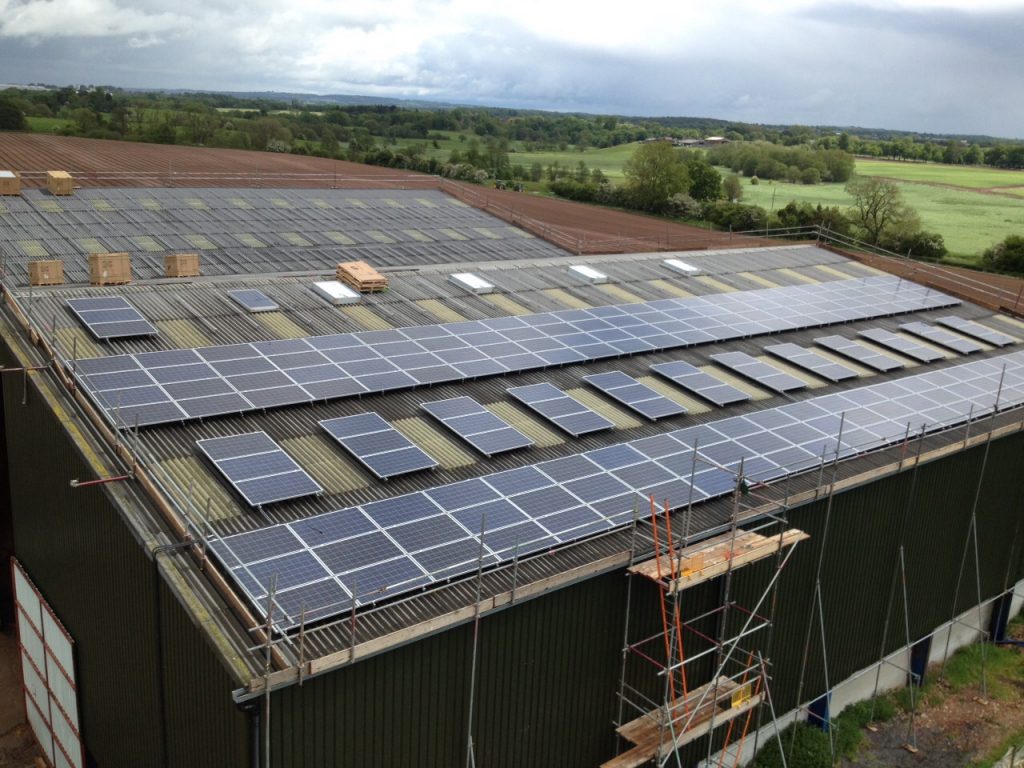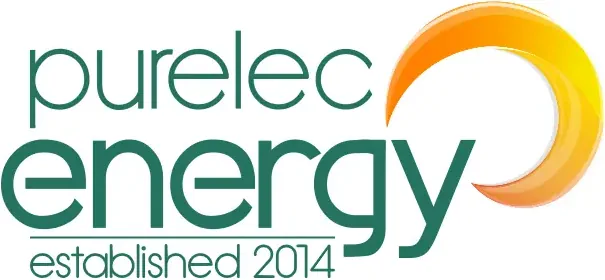
Green Bank Farm – 116kWp array (Using 464 x 250 watt poly crystalline Tier 1 solar panels and 5 x 20kW Fronius Symo inverters)
Due to the nature of Mr Marsh’s business, timing was extremely important. The movement of salt and fertilisers in and out of the sheds at Green Bank Farm happens regularly throughout the year.
To keep disruption to a minimum, we had to work closely with Mr Marsh from start to finish.
After we had sought planning permission and it had been granted by the local authority, we were ready to move to the next stage of the project.
Alongside the other two sites where panels were installed and prior to the installation of the solar panels at Green Bank Farm, purelec energy applied to Western Power Distribution (DNO) to connect the system onto the national grid.
The connection at Green Bank Farm was for a brand new connection, which would allow for the solar panels to export electricity onto the national gird and to supply electricity to the farm and new offices that Mr Marsh was building.
An offer to connect was made by Western Power with a cost of £12,687.00 attached, which we felt was acceptable. At this point we were now able to complete a full structural survey and an assessment on the site’s energy efficiency. The site achieved an EPC rating of D, and we were now in a position to accept Western Power Distribution’s offer and begin the installation.
In the run up to the start of the largest of the three installs, Mr Marsh moved the large bales of straw and hay and cleared a number of channels in the large heaps of fertiliser so that all corners of the large shed could be reached with a cherry picker.
As with all installations that we complete, a thorough assessment of the roof material is completed and if found to be fragile (Materials such as fibre cement, asbestos and sky lights all fall under this category) safety netting is installed.
The roofing material at Green Bank Farm was fibre cement (Big 6 sheeting) an required full safety netting. Once the netting was in place and had been signed off as fit for purpose by the netters, the scaffolder visited site.
A full scaffold was fitted with an access tower and full edge protection around the perimeter of the roofs edge to ensure all our operatives were kept safe whilst working at height on the roof.
As there was no existing electrical infrastructure on site that was suitable of carrying the loads from the solar array back to the new three phase supply origin, we needed to specify all required armoured cables and carefully design the layout.
Mr Marsh prepared the trenches to bury the cables and our engineers on site worked closely alongside his team to lay and burry the cables in as short as possible time to allow the farm machinery to continue access throughout the yard.
The panels were fitted to the large barn roof used to store the fertiliser and gritting salt. The barn had a double apex and panels were located on the two south westerly elevations to capture the greatest yields of energy from the sun.
The inverters were located on the exterior wall of the salt shed, mainly to keep them away from the corrosive ammonia but also for protection from the large moving vehicles. All kit installed is IP rated (water proof).
Due to the scale of the large barns, we had to use a crane to lift the panels up onto the roof safely. We used a local firm who had a full suite of qualifications to demonstrate their ability to help us with the continued safe installation of the array.
As we had done previously on the 44kWp installation at the farm down the road, purelec energy applied to have an export meter fitted on behalf of Mr Marsh. As the system was over 30kWp in size this was required by Ofgem. It allows Mr Marsh to collect payments for all electricity exported back on to the national grid.
In the early stages of the project we also submitted a preliminary application to Ofgem via the CHP register to apply through the Roo-Fit scheme to collect Feed In Tariff payments on behalf of Mr Marsh.
As the array is above 50kWp in size, it does not fall into the Microgeneration category like the other two installations completed prior.
Finally we fitted monitoring to the system, which was linked in with Mr Marsh’s other systems so that the ongoing performance could be assessed.
All systems were linked back to the online Solar Web portal, which can be viewed via a computer or phone.
Upon completion of the installation, The DNO visited site to complete a witness test to ensure the system complied with G59 regulations and their requirements for connection onto the national grid.
purelec energy commissioned the system and we then helped Mr Marsh to convert the preliminary Roo-Fit accreditation to a full accreditation.
As with the other systems we had installed for Mr Marsh, we guided him through the registration of the system with his chosen energy supplier once Ofgem had approved the installation.
We always offer our support to all of our customers to ensure they fill all details out correctly, making sure they are eligible to gain Feed In Tariff and Export payments for the full guaranteed twenty years!
System overview:
Total installed capacity : 1 X 116kWp array (464 x 250 watt panels)
116 kWp Array:
Year one yield : 96,164 kWh
Feed In Tariff : £10,299.16
Import Saving : £1,153.97.00
Export Payment : £4,015.81
Total annual Income : £15,468.94
20 year ROI : £413,434.90
Payback Period : 8.5 years
CO2 saved/Annum: 48 Tonnes
